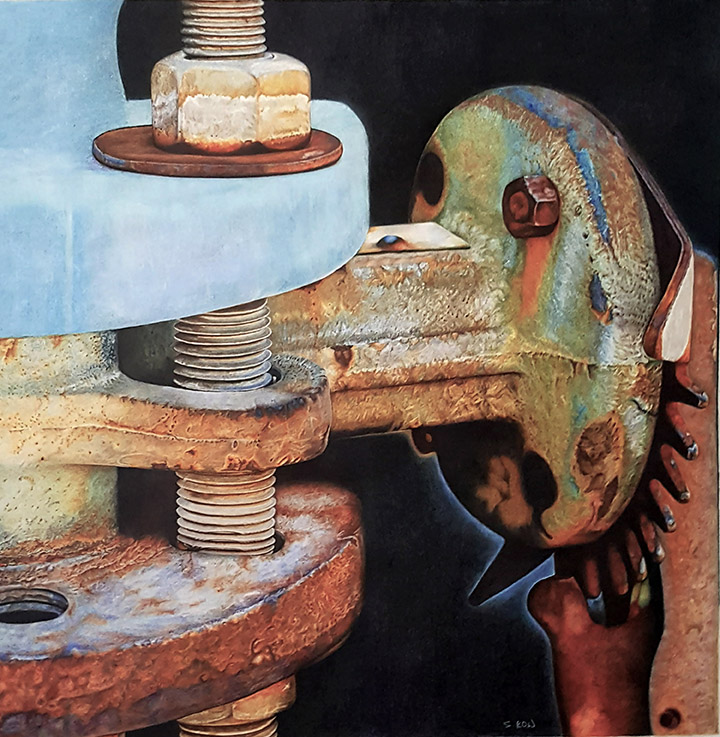Wabi-sabi represents Japanese aesthetics and a Japanese world view centered on the acceptance of transience and imperfection . The aesthetic is sometimes described as one of beauty that is “imperfect, impermanent and incomplete”. Characteristics of the wabi-sabi aesthetic include asymmetry, roughness, simplicity, economy, austerity, modesty, intimacy and appreciation of the ingenious integrity of natural objects and processes. – en.wikipedia.org
Now, what made me want to paint this? Many did asked why and what were my thoughts when I chose this particular subject.
I happened to notice this main water valve by accident. This valve is right by the junction to my house that I drove pass every time but I never took any notice until then. It is something that I, like many others took for granted that it is just there.

I was desperately looking for subject/inspiration for the Langkawi Art Biennale 2016. I need a subject that can be done in a contemporary style, subject with a strong story that we can relate.
I live across a beautiful beach front and I figured why not take a walk and look for inspiration over there, and I did, scouring the beach, twice! I did found something but I was not truly satisfied and the irony was, I walked pass this valve four times.
After almost giving up, I started to walk home, pass the water valve but I felt something beckoning me to turn back but I do not know where to search. So I stood right at the junction and look around, lo and behold, I saw this rusted valve with the wrench, almost glittering under the blinding sun (maybe it was in my head) BUT that was what I saw and I knew immediately, this was it. I took several photos of it in several angles and immediately went home and started my research on rust and decay.
The term, “wabi-sabi” appeared on GOOGLE when I did the research and I was intrigued by the Japanese explanation of decay, it was exactly like how I felt about it. I was fascinated by the multitude of colours in that rusted steel, I see beauty instead of decay.
When I look deeper at the subject, it felt almost human. This rusted valve is very like a human form, when our physical body starts to aged and deemed useless/powerless. Now, Imagine looking at a very elderly person, dry wrinkled skin, physically weak and unattractive, slow… etc.. if we could just spend just a little time listening to them, we will uncover the vast life experiences that they have gained, the contribution that they have provided throughout their lives and so on. That is the beauty I see, not physically but what is inside their mind and heart.
And that is the story behind this subject.
Let me show and explain the process of the whole painting. Colour pencil takes much longer time compared to other medium, it requires much more patience and I do like the challenge.
For this I am using the 300gsm, hot pressed Arches Aquarelle (watercolour paper). Faber-Castell Albrech Durer (Black and Light Blue), a watercolour pencil which I used it wet. Shaved the lead and mix it with water, just like watercolour. This act as a primer to really cover every groove/tooth of the paper so that when I apply the colour pencil, the white speck of the paper suface will not show through. This also help up to slightly speed up the process of colouring the background, which is black.
Also using the Caran D’ache Pablos and Luminance on top of the Faber-Castell pencils for extra vibrancy.

Initial line drawing, need not be precised as long as the composition is accurate i.e. far to near and vice versa.


As you can see from the above two photos of background applications, I need the background to stay very dark but with depth. So it is not only pure black. There are many colours under the black, such as indigo, maroon, orange etc..
There is no necessary order in how I work, I tend to ‘jump’ around in order to keep me from getting bored, especially the background, I had such a big area to cover and it can be very monotonous.


This part of the rust was the most challenging but yet very interesting. I had the feeling of helplessness before I started, the combination of colours was mind boggling. But I told myself, one step at a time and I did it. It took me almost 10 days just working on the rusted part.


I did the same with the light blue, applying the watercolour pencil as primer to keep the surface smooth and using the colour pencil for transition of shades/nuances.



To really go into detail on how I did this will take many pages and hours. All I have to say that whenever I do subject as complicated as this, I always remind myself to enjoy the process, do not rush. Free my mind and let my hand and heart do the work and truth to be told, it works.
